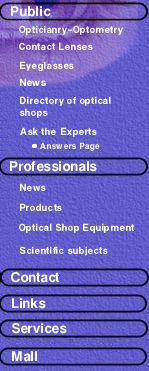|
Eyeglasses
Frames
Choosing
the right frame
The selection of the rigth frame for the eyeglasses is something
that is always difficult, especially if it is your first time. However
there are some rules to follow, thet can be of much help.
Size
The size of
the frame always depent on the size of the face, but there are some
restriction if we want to have a nice result.
-
In cases
of myopia over 3-4 dt it is good to preffer frames that are
as small as possible, because the smaller the frame, the thinner
will be the lens on it and the nicer will be the result. That
is because the thickness of the lenses is higher as we move
from the center to the edges.
-
The same
we sould do in cases of hypermetropia over 3 dt. Only for a
different reason. The hypermetropic lenses have the maximum
of their thickness at the center. Because of this your eyes
look enlarged behind the thick lenses. Using a smaller frame
your otician can use a smaller lens and therefore it will be
thinner at the center.
Also,
in both the above cases the glasses will be lighter if the frame is
smaller
Shape
The shape of
the frame depents on the shape of your face, even if this is something
subjective. There are some basic shapes that we can mention:
- Round
A round face has curvilinear lines with the width and length
in the same proportions and no angles. To make the face appear
thinner and longer, try angular narrow frames to lengthen the
face, a clear bridge that widens the eyes and frames that are
wider than they are deep, such as a rectangular shape.
- Oval
The oval face is considered to be the ideal shape because of its
balanced proportions. To keep the oval’s natural balance,
look for frames that are as wide as (or wider than) the broadest
part of the face, or walnut-shaped frames that are not too deep
or too narrow.
- Square
A square face has a strong jaw line and a broad forehead, plus
the width and length are in the same proportions. To make the
square face look longer and soften the angles, try narrow frame
styles to soften the face angles, frames that have more width
than depth, and narrow ovals.
- Base-Up Triangle
This face has a very wide top third and small bottom third. To
minimize the width of the top of the face, try frames that are
wider at the bottom, very light colors and materials, and rimless
frame styles (which have a light, airy effect because the lenses
are simply held in place to the temples by a few screws).
- Base-Down Triangle
The triangular face has a narrow forehead that widens at the cheek
and chin areas. To add width and emphasize the narrow upper third
of the face, try frames that are heavily accented with color and
detailing on the top half or cat-eye shapes
- Oblong
The oblong face is longer than it is wide and has a long straight
cheek line and sometimes a longer nose. To make the face appear
shorter and more balanced, try frames that have a top-to-bottom
depth, decorative or contrasting temples that add width to the
face, or a low bridge to shorten the nose.
- Diamond
Diamond-shaped faces are narrow at the eye line and jawline, and
cheekbones are often high and dramatic. This is the rarest face
shape. To highlight the eyes and bring out the cheekbones, try
frames that have detailing or distinctive brow lines, or try rimless
frames or oval and cat-eye shapes
Material
Frames are made
basically of two type of materials : plastic and metal. There are
many different types of metal like the cheap ones that can be ruined
in ashort period of time and other like the titanium that are non-corrosive,
and very durable and light-weight. There are some differencies between
these two categories.
-
The way
that the frame stands ont he face is different The metallic
frames use special supports called nose temples. The plastic
frame do nut have such temples, they are in direct contact with
the nose. In most cases this is an advantage, because the plastic
frame has a better contact with the nose and therefore it is
often more confortable. On the other hand the nose temples of
the metallic frames allow the heigth adjustment of the frame,
which is not possible on the plastic frames.
-
A plastic
frame can "hide" a great part of the lenses thichness
in cases of high myopias.
-
The metalic
frames are less noticable and they produce a smaller change
in the appearance o your face.
Generally
| Eyeglasses: Frames | Lenses
| Sunglasses
|




